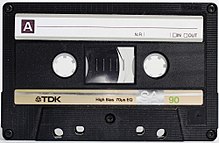Cassette-tape recorder

A TDK SA90 Type II Compact Cassette
|
|
| Media type | Magnetic tape |
|---|---|
| Encoding | Analog signal |
| Capacity | Typically 30 or 45 minutes of audio per side (C60 and C90 formats respectively), 120 minutes also available |
| Read mechanism | Tape head |
| Write mechanism | Magnetic recording head |
| Developed by | Philips |
| Usage | Audio and data storage |
The Compact Cassette or Musicassette (MC), also commonly called cassette tape, audio cassette, or simply tape or cassette, is an analog magnetic tape recording format for audio recording and playback. It was released by Philips in 1962, having been developed in Hasselt, Belgium. Compact cassettes come in two forms, either already containing content as a pre-recorded cassette, or as a fully recordable "blank" cassette. It was designed originally for dictation machines, but improvements in fidelity led the Compact Cassette to supplant the Stereo 8-track cartridge and reel-to-reel tape recording in most non-professional applications. Its uses ranged from portable audio to home recording to data storage for early microcomputers. The first cassette player (although mono) designed for use in car dashes was introduced in 1968. Between the early 1970s and the early 2000s, the cassette was one of the two most common formats for prerecorded music, first alongside the LP record and later the compact disc (CD).
Compact Cassettes contain two miniature spools, between which a magnetically coated, polyester-type plastic film is passed and wound. These spools and their attendant parts are held inside a protective plastic shell. Two stereo pairs of tracks (four total) or two monaural audio tracks are available on the tape; one stereo pair or one monophonic track is played or recorded when the tape is moving in one direction and the second (pair) when moving in the other direction. This reversal is achieved either by manually flipping the cassette, or by having the machine itself change the direction of tape movement and head respectively ("auto-reverse").
In 1935, decades before the introduction of the Compact Cassette, AEG released the first reel-to-reel tape recorder (in German: Tonbandgerät), with the commercial name "Magnetophon". It was based on the invention of the magnetic tape (1928) by Fritz Pfleumer, which used similar technology but with open reels (for which the tape was manufactured by BASF). These instruments were very expensive and relatively difficult to use and were therefore used mostly by professionals in radio stations and recording studios.
...
Wikipedia
